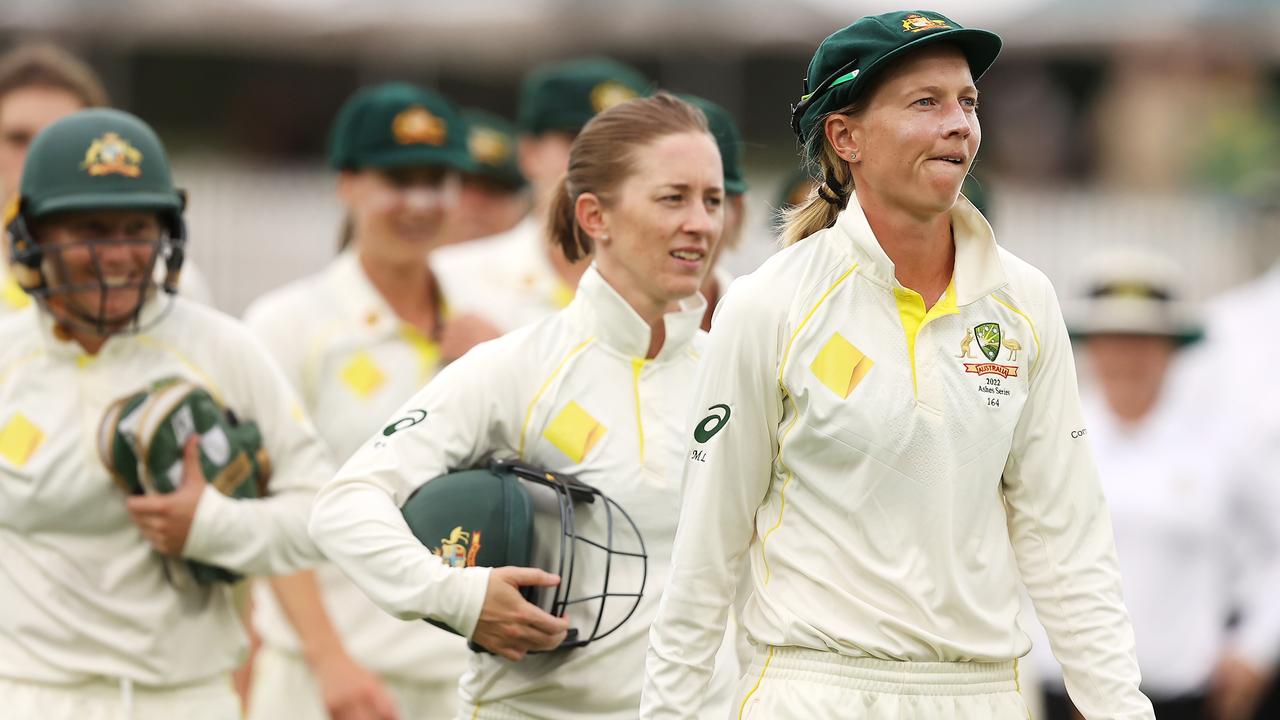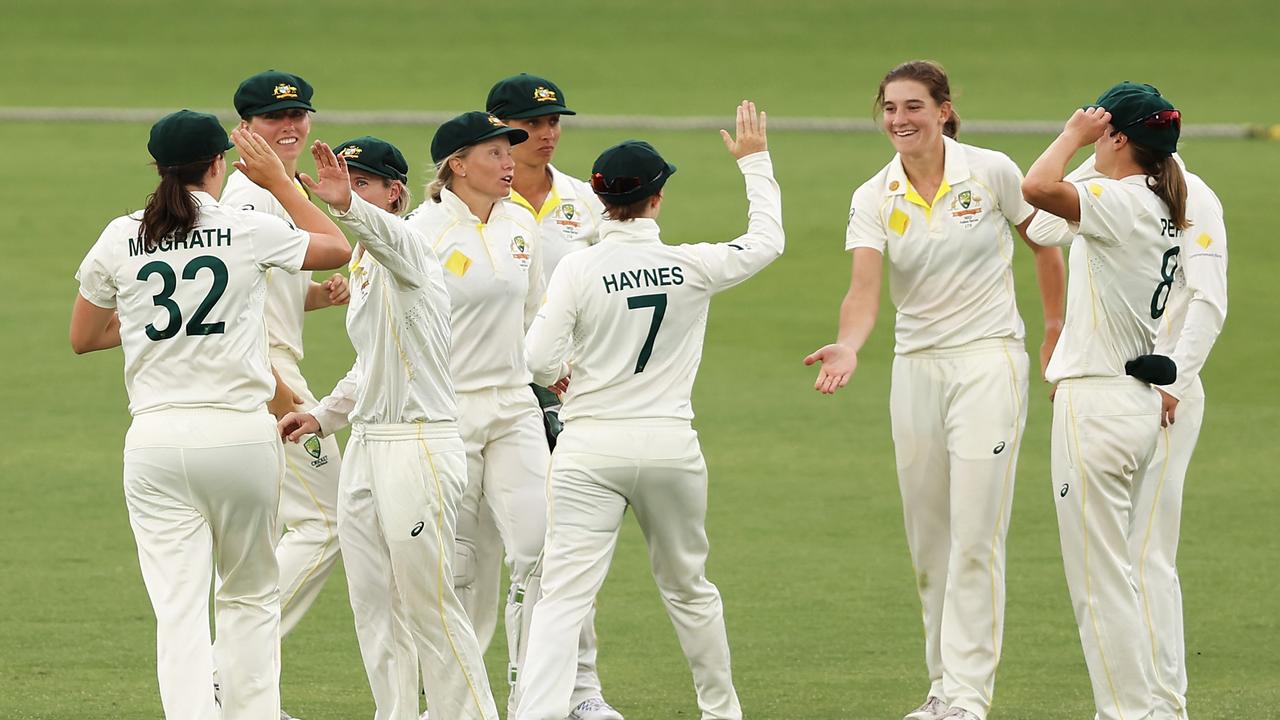Canberra thriller proves there’s an appetite for more women’s Test matches
Objective analysis and criticism is vital, but how can Meg Lanning and her teammates improve when their next home Test is four years away?

449 runs, 14 wickets, 107.1 overs.
Australian cricket fans have been yearning for the national women’s Test side to have an opportunity to showcase their talent on a high-quality pitch, and that’s precisely what they got on Sunday.
Day four of the women’s Ashes Test at Manuka Oval featured multiple dramatic shifts in momentum, with all four results possible leading into the final few overs.
Watch the CommBank Women‘s Ashes Series on Kayo. Every Test, T20 & ODI Live & On-Demand. New to Kayo? Start your free trial now >
Heather Knight’s classy counter-attack, Katherine Brunt’s swing bowling masterclass, Beth Mooney’s outfield catching, Sophia Dunkley’s explosive cameo, Meg Lanning’s contentious strategies – there were countless storylines to unravel.
It’s been compared to the ending of last month’s New Year’s Test in Sydney, where England tailenders James Anderson and Stuart Broad survived 12 deliveries at the crease together to clinch a gritty draw.
But last week’s contest in Canberra featured an added layer of drama, with an England victory still a possibility with three overs remaining in the match.
There’s been plenty of debate and speculation about women’s Test cricket since the drawn contest, but pundits and fans unanimously agree on one thing – we want more of it.
Sunday was the most-watched day of a women’s Test match in Australian cricket history. An average free-to-air audience of 440,000 witnessed the final session, while the total number of Australian viewers across broadcast and streaming services surpassed two million. There’s clearly an appetite for women’s Test matches.
Former Australian captain Alex Blackwell tweeted: “A pivotal moment in women’s cricket occurred on Sunday. Well done to all the players and coaches for encouraging a positive style of play. This could be the springboard for more test cricket for women.”
Five-time Ashes winner Ian Bell posted: “What a sensational Test match this was. It had everything, and that last hour was brilliant to watch. Credit to Australia for an awesome declaration and unreal batting from Heather Knight too. More of these Tests please.”
Shame there’s only one! Great test match ðŸ‘
— James Anderson (@jimmy9) January 30, 2022
Shame there's only one test #Asheshttps://t.co/wW6VZ0tGXc
— Sarah Taylor (@Sarah_Taylor30) January 30, 2022
I have honestly never felt so sick in my whole entire life!
— Alexandra Hartley (@AlexHartley93) January 30, 2022
Not just any draw one of the best I’ve ever seen!
Kudos to Lanning for declaring when she did to set up an extraordinary test match.
THE SERIES IS STILL ALIVE!
LET PLAY MORE TESR MATCH CRICKET #ashespic.twitter.com/SigKyY3hRn
Former Port Adelaide footballer Kane Cornes sparked debate this week after he penned an editorial calling for more objective analysis of women’s sport.
Women’s sport needs criticism to thrive, but several media outlets have been analysing and critiquing women’s cricket for years, celebrating the triumphs and scrutinising the failures. As pointed out by broadcaster Emma Race on Wednesday, those who can’t see it seemingly aren’t looking hard enough.
Cornes also took aim at Australian captain Meg Lanning, accusing her of having a “shocker” on day four of the Ashes contest.
Lanning was undeniably rattled when Knight and Nat Sciver started finding the boundary rope with ease early in the evening session. The Australian skipper responded by putting six players on the fence, allowing England’s batters to rotate the strike, a move that quickly backfired.
Lanning will reflect and acknowledge her mistakes, but also take pride in her successes. For example, her decision to introduce teenager Darcie Brown into the attack in the 31st over was a masterstroke.
Brown was averaging 109.00 with the ball in Test cricket at that point, while Knight was essentially 215 not out following a record-breaking knock in the first innings.
But in a game-changing spell, Brown needed just two deliveries to knock over the England captain, trapping her on the front pad.
Then, instead of turning to veteran all-rounder Ellyse Perry in the final 30 minutes, Lanning threw the Kookaburra towards 20-year-old Annabel Sutherland, who had conceded 51 from her first eight overs in the day.
Sutherland immediately repaid her captain’s trust, taking the crucial wickets of Sciver, Amy Jones and Brunt to put Australia within touching distance of a shock victory.
It was one of Lanning’s many inspired moves in that dramatic final session, along with several errors.

But importantly, Lanning and her teammates have rarely encountered situations like day four of Canberra, simply because long-format cricket is such a rarity.
Lanning has led Australia in 150 matches since 2014, but only four have been Test matches. Comparatively, men’s skipper Pat Cummins has already captained Australia in four Tests after only two months in the role.
As pointed out by cricket writer Isabelle Westbury on Twitter, the three protagonists in the final hour of the Canberra Test were Dunkley, Sutherland and Alana King. The trio collectively had two Test caps between them.
There’s also no long-format domestic competition in place for the women’s players to develop their skills and prepare for the challenges of Test cricket. The men’s players, of course, have the Sheffield Shield.
Some of Australia’s younger cricketers hadn’t played with a red ball in more than five years before last week’s Test.
“Stella (Campbell), Darcie and I were thinking about when we last played red-ball cricket, it would have been under-13s,” Sutherland said following the Canberra Test.
Objective analysis is a necessity for women’s Test cricket, but they need to actually play some long-format matches for that criticism to be beneficial. How can Lanning and her teammates improve when their next home Test could be four years away?
Since 2000, the Australian men’s team has played 237 Test matches compared to just 17 for the women. Ellyse Perry, who arguably could have been Australia’s greatest Test cricketer since Sir Donald Bradman, has only played 10 of them since her international debut in 2007.
Test cricket…we need more of it! Any opportunity to represent @AusWomenCricket is special but wearing the Baggy Green is next level. I’m still trying to process what happened yesterday 🤯 #Ashespic.twitter.com/e4E1KXqGlK
— Jessica Jonassen (@JJonassen21) January 31, 2022
Well played Meg Lanning, Heather Knight and both teams. In just 10 sessions (not because of it), they've engineered an excellent, compelling Test. More of it, across five days. And also, crucially, time for multi-day domestic women's cricket. Let this be a springboard. #Ashes
— Adam Collins (@collinsadam) January 30, 2022
“Just from a playing perspective, the more we play, the more we get used to that,” Sutherland told reporters this week.
“We just love being able to put on the baggy green, so it’d be cool to be able to play more.”
Australia’s women played two Tests this summer, which will hopefully become the norm over the coming years, but the next step is a domestic long-form competition in which the states play several matches a season.
“That‘s a really important next step for the women’s game,” Lanning said in regards to expanding the domestic women’s competition.
“It‘s the pathway, it’s the breeding ground for young cricketers to go out there and play and learn their craft.”
Australia’s last four women’s Tests have ended as draws, and more than 60 per cent of matches in the history of women’s Test cricket have failed to produce a result. If the players could polish their long-format skills every summer, the scoring rate would quicken and wickets would fall more frequently, reducing the number of draws.

The standard and depth of women’s cricket would improve drastically if administrators and broadcasters backed such a move. It may not be economically rewarding for Cricket Australia in the short term, but they need not look further than the Women’s Big Bash League for inspiration.
Less than seven years after its inaugural season, the WBBL ranks as the fourth-most watched domestic sporting competition in Australia, behind only the NRL, AFL and BBL.
Incredibly, this summer’s WBBL final drew a substantially larger crowd (15,511) than last week’s BBL final at the MCG (10,333).
An annual women’s Test match at North Sydney Oval or Manuka Oval could be a welcome addition to the national sporting calendar.
However, not a single women‘s Test match is scheduled for any cricket nation on the ICC calendar at the moment. Hopefully that changes very soon.
On Monday, a Cricket Australia spokesperson said: “We are working through the new women’s Future Tours Program at the moment.
More Coverage
“Cricket Australia is supportive of playing as much Test cricket as is practical, as evidenced by hosting Test matches versus both India and England as part of multi-format series this season, while supporting the global growth of the women‘s game.
“The Ashes Test at Manuka Oval was utterly compelling viewing and Sunday was our most watched day of women‘s Test cricket on record.”
The women’s Ashes will resume on Thursday with the first of three one-day internationals between Australia and England.





